
Introduction
Email marketing is a digital marketing strategy that involves sending emails to prospects and customers. The goal is to build relationships, promote products or services, and create customer loyalty.
You invested a lot of your time and money framing an email marketing campaign. You have a pretty good database of your clients and are sending them newsletters and offers on a regular basis and the result is – nothing. So what to do? Before we jump into that, let’s find out more about bulk email marketing.
What is bulk email marketing and how to do email marketing through mailchimp [Video Tutorial]
email marketing is the process of emailing potential or current customers with promotional messages about your product or service. Bulk email marketing refers to emailing a large number of people at once. Email marketing can be an effective way to reach a large audience, but it must be done carefully to avoid being considered spam. One way to ensure that your email marketing campaign is successful is to use a service like MailChimp. MailChimp allows you to create beautiful email newsletters and track the results of your email campaigns. With careful planning and execution, email marketing can be an effective way to reach a large number of potential customers.
Benefits of Email Marketing
- Cost-Effective: Compared to traditional forms of marketing, email marketing is relatively inexpensive.
- Targeted: Allows for detailed audience segmentation based on demographics, purchase history, etc.
- Measurable: With the right tools, you can track open rates, click-through rates, and conversions.
- Personalized Communication: Emails can be personalized to a great extent, improving engagement and conversion rates.
Components of an Effective Email
- Subject Line: This is the first thing recipients see. It should be compelling enough to make them want to open the email.
- Body Content: This should be engaging, informative, and provide value to the reader. Use clear and concise language.
- Call to Action (CTA): Every email should have a clear CTA, guiding recipients towards the desired action.
- Visuals: Images and videos can greatly enhance the effectiveness of your emails.
Best Practices in Email Marketing
- Segment Your Audience: Send targeted emails based on various factors like location, age, or purchase history.
- Personalize Emails: Personalization can significantly improve open and click-through rates.
- Test and Optimize: Use A/B testing to find out what works best and optimize your emails accordingly.
- Use Automation Tools: These can help you send out emails at the right time, follow up with customers, etc.
Email Marketing Laws
Ensure compliance with email marketing laws such as the CAN-SPAM Act in the U.S. or GDPR in Europe. This includes getting explicit consent before sending marketing emails and providing an easy way for recipients to unsubscribe.
Metrics to Track
- Open Rate: The percentage of recipients who open your email.
- Click-Through Rate (CTR): The percentage of recipients who click on a link in your email.
- Conversion Rate: The percentage of recipients who complete the desired action (like making a purchase).
- Bounce Rate: The percentage of emails that weren’t delivered successfully.
Remember, the key to a successful email marketing campaign is to send the right message to the right person at the right time.
Step-by-step pointers to run a successful email marketing campaign
- Build a Targeted Email List.
- Know Your Goals. (Get new subscribers or re-engaging existing subscribers or segmenting subscribers)
- Understand Email Types. (Promotional, Transactional, Relational, Automated Drip feed / Triggered base)
- Know Your Audience.
- Use Technology Wisely. (Choose right email marketing platform)
- Create Great Optins. (Welcome Gate, Lightbox pop up or exit intent pop up)
- Plan Emails and Followups.
- Craft Your Subject Line.
- Write effective email newsletter (Add value)
- Monitor & Test (Open Rate, Click Rate, Inbox reach, bounce rate, spam)
What to do for an effective email marketing campaign?
Yes! It is quite a common scenario where email marketing campaign fails despite doing everything that others (with a better ROI on their email marketing investment) are doing. We do agree that sometime even the best-practices do not work, but before accusing your luck make sure you are doing it right. And by “right” I mean the proper way (more of your etiquette) than the proper thing (the so-called best practices).
An effective email marketing campaign requires careful planning and execution. Here are some steps to consider:
- Set Clear Goals: Before you begin, define what you want to achieve with your email marketing campaign. This could be increasing website traffic, boosting sales, or improving customer engagement.
- Know Your Audience: Understand who your target audience is. This will help you create relevant content that resonates with them. You can segment your audience based on various factors such as age, location, or purchase history.
- Create Engaging Content: The success of your email marketing campaign largely depends on the quality of your content. Make sure it’s engaging, informative, and provides value to the reader. Use compelling subject lines to increase open rates.
- Design Responsive Emails: Ensure your emails look good on all devices. Many people check their emails on mobile, so it’s important to have a responsive design.
- Personalize Your Emails: Personalization can significantly increase engagement rates. You can personalize your emails by using the recipient’s name or by tailoring the content to their interests or past behavior.
- Test and Optimize: Always test different elements of your emails (like subject lines, content, CTA placements) to see what works best. Use A/B testing for this purpose. Based on the results, optimize your future emails.
- Measure Success: Use metrics like open rate, click-through rate, and conversion rate to measure the success of your campaign. This will help you understand what’s working and what’s not, allowing you to make necessary improvements.
- Follow Email Marketing Laws: Make sure you comply with email marketing laws like CAN-SPAM Act in the U.S. or GDPR in Europe. This includes getting explicit consent from recipients before sending them marketing emails.
Remember, effective email marketing is not about sending as many emails as possible. It’s about sending the right message to the right person at the right time.
Top 10 Email Marketing Tools
Here are some of the top email marketing tools:
- Mailchimp – Often regarded as the best all-in-one marketing tool, Mailchimp offers a comprehensive suite of services beyond just email marketing. It’s known for its user-friendly interface and robust analytics.
- HubSpot Email Marketing – A part of HubSpot’s extensive marketing hub, this tool offers a range of features including personalization, analytics, and automation.
- Sender – Known for its simplicity and effectiveness, Sender is one of the free email marketing tools that offer features like automation, analytics and segmentation.
- Sendinblue – This is a powerful email marketing tool that also offers SMS marketing capabilities. It’s known for its advanced automation features.
- Omnisend – Omnisend is a multi-channel marketing tool that integrates email marketing with other channels like SMS and social media.
- SendPulse – This tool provides a range of features including email marketing, web push notifications, and SMS messaging.
- Constant Contact – It’s an easy-to-use tool that offers a variety of customizable templates, along with tracking and reporting features.
- MailerLite – Known for its ease of use, MailerLite is a universally good tool for any industry. It offers features like automation, segmentation, and advanced analytics.
- ActiveCampaign – Best for automation, ActiveCampaign offers advanced features like CRM integration, lead scoring, and machine learning capabilities.
- Keap – Formerly known as Infusionsoft, Keap is a comprehensive sales and marketing platform that includes an email marketing tool.
Remember, the best email marketing tool for you depends on your specific needs, budget, and the size of your business.
Email Marketing Guide [PDF Handbook]
There are certain things that you need to keep in mind with your email marketing campaign. The guiding principle is to ‘Never overdo it’. We have a few suggestions to make your email marketing campaign successful:
How to make your email marketing campaign successful
Offer something useful
The reason you are reading this article (or any of our article as a matter of fact) is because you found them useful and interesting. The same applies for your email subscribers. They are sharing their email address with the expectation of getting something valuable and interesting out of the transaction. Thus, focus on creating relevant, useful and interesting content for your newsletters and emails. And of course a little bit of fun wouldn’t hurt too.
Related reading: How to create lead magnet & lead funnel?
Limit the number of messages
Sending same messages over and over again is considered as spamming and nobody like spammers. Also, people already receive a whole lot of emails throughout a day and then they have the work accounts as well; so be a little considerate while sending a wave of emails. So follow the basic guideline of never overdoing it here. Our suggestion is 1 email per day (2 emails a day should be the maximum limit), if you have something helpful to offer.
Make interesting subject line
The subject line is the place to grab your reader’s attention. And if you fail to make them interesting enough, your readers are likely to fail noticing them. Also, refrain yourself from making a subject line that sounds like an advertisement tag line. Your readers may feel like being push to buy something and will lose the interest even before opening the email. Rather, make subject line that “sound more like a newspaper headline” to grab their attention, as they would feel like being provided with something informative and interesting.
Make it personalized
Address your users with their first name while you send your emailers. Personalized emails get better ope rate.
Never shout at your receivers
YOU KNOW YOU SHOULD NEVER DO THIS, RIGHT! Well sorry for that but really this a basic etiquette. And for the laymen, let me tell you in this virtual world writing in ALLCAPS in similar to shouting at people in real world. Apart from practicing poor Internet etiquette, such practices will also filter you into your receiver’s spam folder – not something you really want to do, do you?
Clear Call To Action
And finally, include a call to action to tell the audience what you want them to do.
Related reading: How to increase conversion rate
Types of emails in email marketing

What are the various types of emails in email marketing? What are the various types of email marketing campaigns? A quick look at my email inbox this morning and I was astonished at how most brands fail to optimize the email marketing medium! While smart technicians help them slip through into the inbox, instead of heading for the spam tray, most of these emails are deleted, unread and unopened. I’m not even considering the prospect of clicking on links embedded in the emails and the Click through Rate (CTR)!
To put out my thoughts on email marketing, I’m writing a couple of posts dedicated to this division of digital marketing. In these posts, I will talk about the types of emails (in this post). If you are thinking about launching an email campaign to put the word out about your brand, you can gather some vital information from these posts.
Introductions over, let’s get started! There are several types of emails in email marketing. I’m listing them here, not in any order of importance, but in a random manner.
- Newsletters: This is the most common among emails that carry the torch of marketing right into our email inbox. These emails have information, often with pictures and images, along with backlinks leading to the website of the brand. Usually, newsletters are a weekly or fortnightly affair. Some major brands rely on monthly newsletters as well.
- Blog Posts: These are emails that hop into our inbox with information and links about a blog post published on a blog where we have subscribed. More often, the blog post is all there in the email, so you don’t need to go to the blog and read it! Sometimes, the URLs on the titles and a bit of the first paragraph are embedded in the email, like the 7boats.com email that we put out.
- Updates: These emails are like your personalized alerts, informing you about events, updates and other developments in areas where you show an interest. Usually, these are genres where you choose to receive alerts in. For example, when you subscribe to receive alerts on data backs from Vodafone, those alerts come via email.
- Information: This is slightly similar to updates, except that these emails may come in to inform you about matters that you have no knowledge of. To borrow the above example, an information email from Vodafone might be about the launch of 4G services in a particular circle. Information emails can be educational as well.
- Offers: This is the most common among all of these emails! Self-explanatory and most often, ignored! Offers in the form of emails give you an idea of price cuts, discounts, rebates, two-for-one and other deals. Shops these days often pick up your email id to send you these offers.
- Reports: These emails can be audit reports or status updates on progress done in fields where you show an interest. For example, once you sign up with a project, non-profit or otherwise, they may continue to send you reports, annually or bi-annually, even after you quit the board! Reports can also come in from investments you have made or from insurance companies.
- Transactional: This category is rather broad. It can be emails to confirm subscription or to confirm an order that you have placed. With more app-based activity these days, brands often sent you an email to confirm your email id. Transactional emails can be for ‘drip campaigns’ (automated emails pre-written and scheduled to be delivered to the inbox over a period of time) as well.
- Lead nurturing automated e mailers
Types of email marketing campaigns
Apart from the previous list of types of emails in email marketing, there are a few more types of emails in email marketing campaign.
- The Welcome Email Series. (Introduction, welcome emails)
- The Standard Promotional Campaign. (Regular bulk e mailers)
- The Seasonal Campaign. (Occasion based promotional campaigns )
- The Triggered Email Series. (With automated email marketing, you can have a user’s action trigger a series of targeted and relevant emails.)
- The Post-Purchase Drip. (With automated email marketing, you can send triggered based follow up emails)
- The Connect-Via-Social Campaign. (Connect users to your social media via email marketing – Cross platform promotion)
- The Newsletter. (Regular type smart e mailer like weekly digest or recap or weekly stories)
- The Cart Abandonment Campaign. (Specific automated triggered e mailers for people who abandoned cart in your ecommerce store)
- The Re-Engagement Campaign – A series of emails sent to inactive subscribers.
It is important to understand the kind of emails you want to write so that you can optimize them for better readability. Emails are not newspapers that the user buys and therefore feels obliged to read. Unless there is a genuine interest in the email the reader will barely glance at it! This interest is there only when the user is seriously concerned and anticipates the delivery of the email. For the rest 99% of the time, email marketers have to jostle each other for attention!
And what catches the eye before anything else when an email lands in your inbox? It is the Subject Line. Stay tuned next week for ideas on how to work subject lines to your advantage!
Some Basic Facts about Email Marketing

Despite all the new-age online marketing methods that are available on the internet today, email marketing remains a top choice for online marketers. There are many factors that work in favor of email marketing: targeted consumers, personalized marketing messages and excellent opportunities to drive online traffic to web pages that you want the receivers to visit. However, to launch a successful email marketing campaign, you need to get the basics right.
Here are some pointers to take you in the right direction when it comes to email marketing:
Subscription Point
Email marketing will be a failure if you don’t reach out to a wider cross-section of online users through subscription points. Your aim would be to enable more users to sign up or subscribe to your email newsletters. The opt-in facility is a must for email marketing campaigns. Do not add up people to your email list through decoys or pre-checked options. Then you will be sending emails to unwilling recipients, endangering your campaign and also your IPs!
List Administration
Keep a close track of your emailing lists. The database programmer must have a clear idea about the number of receivers and their geographic locations. You need to get rid of invalid users and also those who have opted out of your email marketing campaign. Track down spambots and erase them off your list.
CAN SPAM Act
The CAN SPAM Act guides all email campaigns. Follow the statutes of the Act like law. While discussing the Act in detail is beyond the scope of this post, we can touch upon a couple of them. Like getting rid of spam words and spam-triggering words. For example, words like ‘deal’ or ‘girlfriend’ are sure to trigger spam alerts that are detrimental for your IPs.
Content Plan
Email marketing thrives on content. The template of an email campaign must be clutter-free with plenty of white spaces. Cramming too much will repel receivers of your emails. The writing should be easy to read and end with a call to action. Provide strategically placed hyperlinks and anchor texts in the email. Use images judiciously but opting for heavy images are a strict no-no. Finally, while drafting the content, use personal touches and address each receiver by name.
Related reading: How to write excellent content
Check out some great email marketing campaign infographics below.
Email Campaign Delivery Checklist [Infographic]
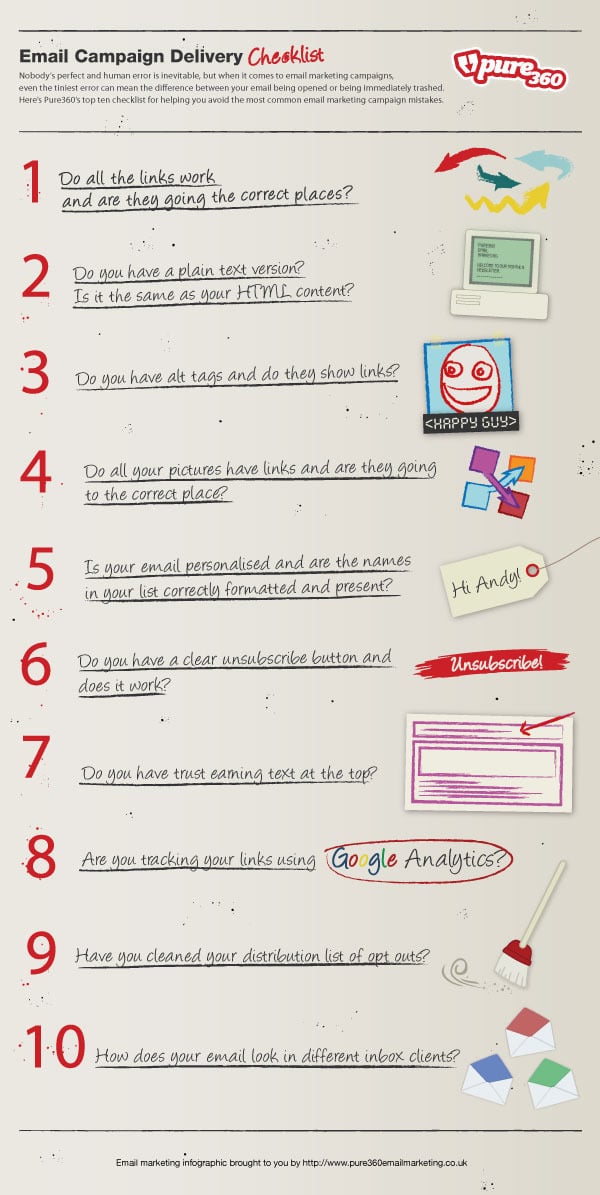
Email Sending Timeline Infographics
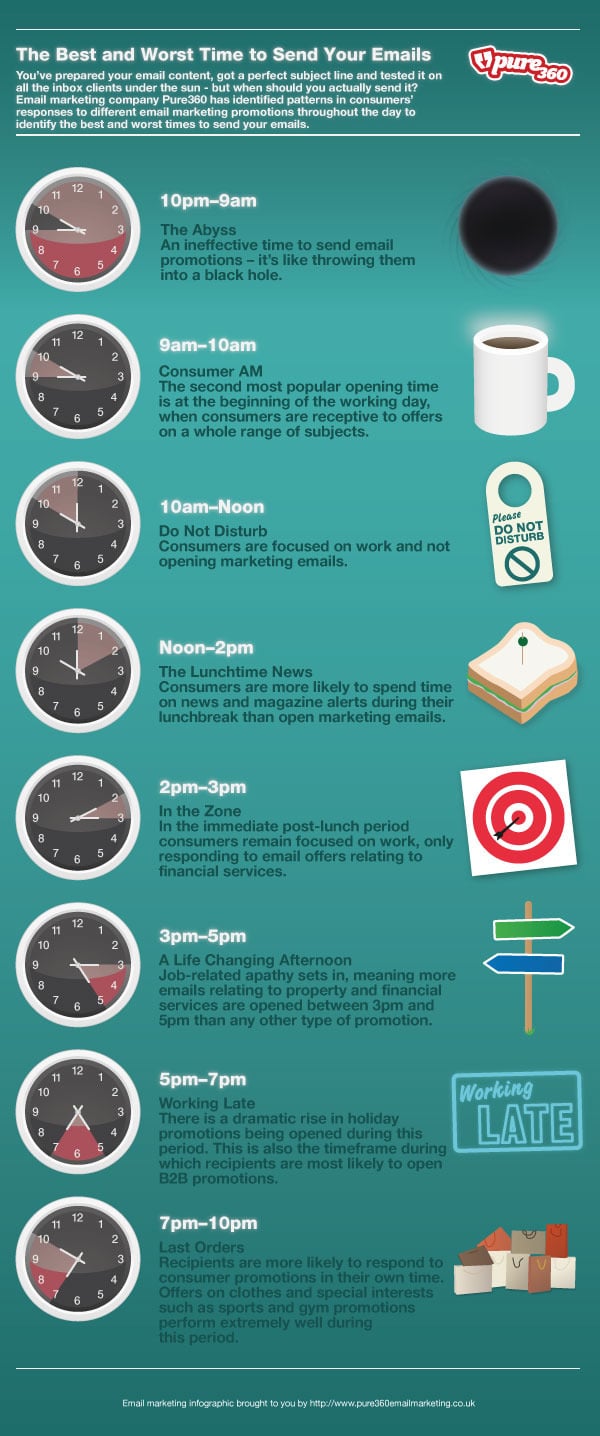
Anatomy of an apple email – Infographics
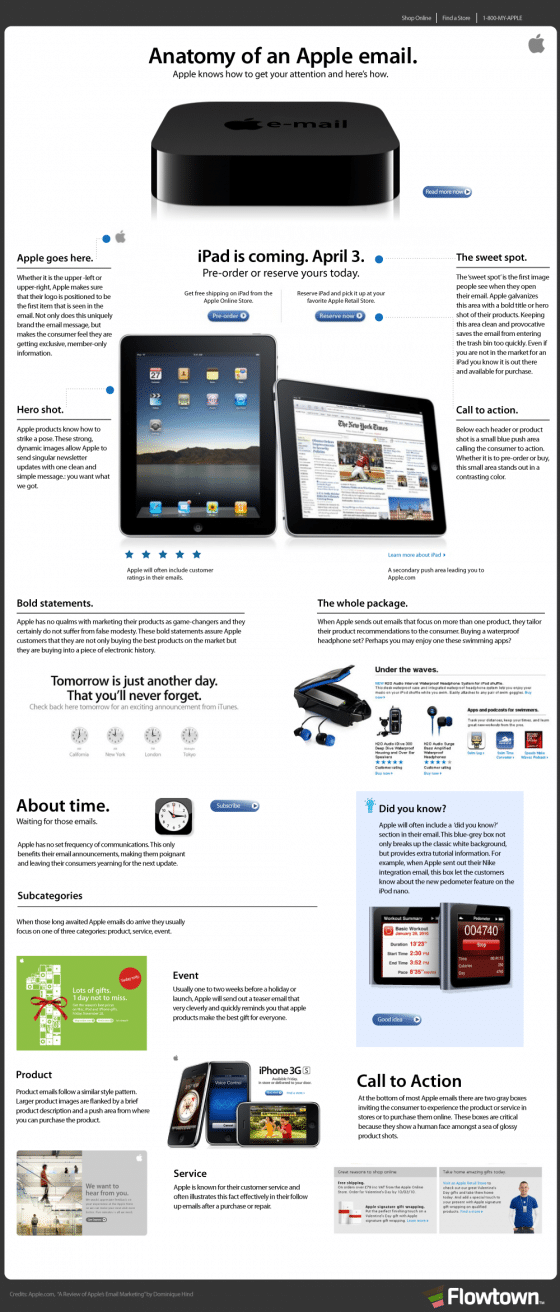
How to measure the Effectiveness of an Email Marketing Campaign
Learn how to assess the effectiveness of an email marketing campaign. An insightful discussion on assessing the effectiveness of an email marketing campaign from various business POV.

As is the case with the majority of marketing practices, one of the most essential aspects of an email marketing campaign is measuring its effectiveness.
It is through this analysis that the business waging the campaign is able to ensure they are acting positively, getting the desired results and can make any necessary changes as and where appropriate.
With this in mind, there are a number of ways of measuring the results of the practice.
Inbox arrival
As is the case with any advertising or marketing medium, one of the best ways of assessing the effectiveness is to assess how many customers have received the message. In the case of email marketing, this is measured by the number of customers who have received the email into their inbox.
Many free email providers have spam filters and uninvited emails may land here by mistake.
Many people check their spam or trash cans on a regular basis to ensure that no emails have landed there by mistake and some providers (such as GMAIL) alert their customers when they have flagged a message as spam so that the customer can check for themselves.
However, the easiest way of avoiding the dreaded trash can is to ensure that customers have signed up for the campaign and are expecting messages.
Targeting a demographic
Rather than sending out a general or blanket email which invites all customers, many businesses choose to send out targeted emails to certain groups of customers which gives them a better chance of receiving a reply from a smaller number of customers.
It might be that the business has a separate filter for new and existing customers or one which only targets customers who have brought certain services in the past and sends them details of similar products or services.
Targeted emails allow the business to much more easily assess the amount of return business.
Assessing
The key with any marketing campaign is to weigh the results against the amount of effort which was put into the campaign. Sending out emails to 1000 customers and receiving 1 enquiry or sale as a result might seem like a poor result but when analysed, if it took five minutes to send out those emails and the result was £1000 worth of business which might not have otherwise existed then the result might be seen in a more positive light.
The key is to view and assess the results in context and consider them on a regular basis. This will give the business in question a much better opportunity of making any changes which might be necessary and tweak the campaign so that it is more successful and profitable in the future.
Testing
The golden rule for the majority of marketing campaigns is to test them first. For this reason, many businesses start by targeting a small control group and assessing those results before they roll out to a larger audience. This gives them a better opportunity of getting their campaign right before they “go public”.
Related Reading: Top 10 free email marketing tools
Email Marketing: Cues for Testing
Marketing through emails and newsletters is a major tour de force in the arena of digital marketing. Despite its significance and potential, email marketing is often touted as the go-to zone for spammers and black-hat marketers. Unwanted and unsolicited emails are sent to people who have never signed up for it or even have anything to do with the brand! This post is, however, not about addressing those issues because they are written about and discussed all the time. Here we will talk about those bona fide email marketers.
Now testing is a must for email marketing. Before you continue to send out the same kind of emails to your database, you need to figure out if it is paying you optimum dividends. If not, you need to tweak your strategies a little. When you mention email marketing straight off the bat, the first thing that comes to mind is the subject line of the emails that you send out. The subject line decides whether the receiver opens the email or simply trashes it. Put in other words, you have to keep testing for the best subject line you can draft for your emails.
Cue 1
But that is not all! Having a great subject line is only half the job done. By tracking the open rate on your emails, you know how many of the receivers have checked on your emails. Does that serve your purpose? You need these receivers to click on the body of the email or newsletter and visit your web pages. You need to give yourself the best shot at converting these receivers into customers.
In order to make that happen, you need to measure the click through rate or the CTR. This will give you an idea about the content that you are dishing out to receivers. If you have a decent CTR, you are doing well on the content and designing. Otherwise, you need to get creative and do some brainstorming.
Cue 2
Going back to the question about the subject line, we know that various email service providers offer varying lengths on this. For example, Microsoft Outlook allows about 52 while Gmail is more flexible at 63. These numbers depend on the settings of the receiver as well. For the sake of uniformity, we can say that the least number of characters are 38 and the upper limit is 94. Studies show that the optimum number of characters in a subject line is right bang in the middle: 51!
You may ask here: why bother with measuring subject line characters when it is more important to write a quality one? You’re right there! But it is also a point that too few in the subject line makes it look spammy or incomplete and too much will cut off the line in some email settings, maybe exactly where you don’t want the axe to come down!
Cue 3
Make use of statistical tools to make more sense of test results. There are a lot of factors riding on the results thrown up. The action rates, the size of the sample database used and the gap between the action rates are some of the factors that you need to consider. Feed them into your statistical algorithm and find out what they mean to you. There are cases when these differences are just random background static noise that distorts results. Many email marketers may not have the statistical tools necessary for measuring it. There are a number of them available online, like visualwebsiteoptimizer.com.
Cue 4
Tangible values always have an appeal for receivers. They need to know why they should bother opening your email at all! You have to give them what they want to hear about, like an area of concern, a mobile app maybe or even a question of value, be it good or bad. These have an instant connect with the viewers and with testing, you have to find out what works for your emails. Check the open rates against subject lines with each of these themes and you will find out the one that gives you the best results.
Final Word
Email marketing is yet to reach its potential in terms of revenue generation, mainly because very few are actually able to do it right. It’s a different kettle of fish that we’re talking about here and we are constantly questioning, innovating and exploring for ways. Do you have some other suggestions about email marketing that you want to share with us here? We’d like to hear and discuss!
Why Email Marketers Need to Prune Subscriber Base

According to a statistic, email users will receive 140 emails everyday by 2018!
This may hold out to be true primarily because of the number of email marketers sprouting up every single day. They put together an email subscriber database hastily and pump out emails. More often than not, the emails are junked at first sight! You waste money and resources to land in the junk box, worse, reported as spam.
The trick to turn this scenario around is to prune your email subscriber base yourself. Here are some reasons why doing so will make your email marketing initiative a more effective one.
- Hit delete on subscribers who have chosen to unsubscribe but are still hanging around in your database because you have not bothered to clean the house yet. There are email receivers who bounce away at the first sign of engagement. Delete them as well. If you have purchased an email list from a third party, make sure you clean up the database before sending out emails to those ids.
- Find out email subscribers who make little to no engagement through your newsletters. A database programmer can do the job for you. These subscribers will add no value to your business anyway so there’s little point in sending them emails at all. Use the last 5 email campaigns as a metric. If they have remained passive, they are less likely to engage again.
- Send these second group of subscribers campaign content for re-engagement. Re-marketing your services or products to them is a better idea than continuing with the usual marketing messages. They are clearly not buying with the messages you are sending over now. A different approach might finally bring them back to the buying fold.
If you play your cards (or, emails!) well, you can turn things around.
Email Marketer’s Nirvana: Facebook!

Does it sound a little out of tune for you? Yes, you are aware of branding and product promotion and selling on Facebook. Yes, you know that you can take your content to a wider audience through Facebook. Can it help your email marketing campaign as well? Yes, it can! Think of all those email ids that users have to use to subscribe! How would it be if users could subscribe to your email list through your Facebook page and you could add them to your email list without them having to visit your email subscription page on the website? That would mean something, would it not? Let’s find out how!
Install the App
Thanks to the availability of online tools, these jobs are not so difficult to manage anymore. You need to install the app that allows you to collect email ids for your email list. This app depends on the email service provider that you are using. It can be something like AWeber, Get Response or Mail Chimp. Search by adding the words ‘Facebook opt-in’ in the search box after the name of the service provider. For example, AWeber users need to type in ‘AWeber Facebook Opt-in’.
When you find the right app (usually the first result on the search), you need to add that app to your page by clicking on something like ‘Add the Mail Chimp app’. Once you find the checkmark on the app, you have to click on Add Page. Once you do that, you can head back to your Facebook profile and find a logo of your email service provider, along with an option like Email Signup. This step is not done, unless you configure the settings on this, and hit on ‘Allow Access’.
Choose the List
With the app installed, it is time to choose the email list from your email service provider account. You can do that through the dropdown menu or create a separate list exclusively for Facebook. You can use auto responders to welcome your subscribers. You can create and manage lists through options that clearly state their purpose.
Get the Web Form
Now we have come to the part where you select the web form for your potential users to fill up. There are different and varied options to do that. You can get a preview of the selected web form before actually adding it to your Facebook profile.
To make matters easier, there is a default web form for all email service providers. Savvy email marketers may not like the indifferent template and designing! You have the option of customizing the web form so that it looks more like something that is attached to your brand name. You can use the Create Your First Signup form to customize web forms.
Ready to Roll
With these changes made, you can save the changes and start the process. Make sure that the app box on your Facebook page that users will click on to signup for your email list looks and feels attractive. This is the call to action button and it must look like something that users would like to click on. You will get the option of editing the logo by moving your computer pointer over the logo.
You should give the logo a name that users may like to click on, other than the logo image. Since both these options are subject to modifications and editing, you can use your discretion and make the changes. To get full value for all these changes that you make, you should try to bring in heavier traffic to the Facebook profile. Use Facebook ads to do that.
The Final Word
As we move into more competitive online marketing zones, we have to make optimum use of resources to target customers and provide them with convenience to use our services. The more you make life easy for customers, the more they will come to you. Using Facebook pages for email subscriptions ensure that you are cutting down the delay in taking potential subscribers to a designated subscription page and then make them sign up. This is convenience and that spells sales for your brand.
When E-mail Marketing Drives Readers to Action
Do you have any idea that what was the first form of digital marketing? Undoubtedly E-mail Marketing. E-mail remains one of the most important web technologies all over the World. At least once every day, 91% of all email users worldwide check their e-mails in this age of social media mania.
Here are some ways to maximize e-mail marketing’s potential for your own brand-
- We all measure every aspect of online marketing platforms which include page views, conversion rates, CTRs etc. You can also check email activity to help you understand your end users including their actions, motivations, and preferences. Analytic tool, such as GetResponse permits you to examine aspects of your emails and user interaction. The aim is to upgrade your marketing efforts more precisely.
- You can directly ask your clients about their requirements and opinions by using email marketing. To justify your brand’s popularity, e-mail your audience surveys about customer satisfaction levels, their demands and interest- there are unlimited options which help you form relationships with your readers.
- Many people do this huge mistake of only putting social sharing and connection icons in their website. It’s a proven fact that if you put social sharing and social connection buttons in your e-mail then you will have a CTR (Click -through rate) that is 115 percent higher than those who don’t use this button.
- E-mail retargeting is a process through which you can concentrate on various customer actions that create automated emails from your side. These actions can add an abandoned shopping cart. For example, explain the immoderate shopping cart in detail, sometimes a visual indication helps to solve indecisiveness and triggers a purchase.
If e-mail marketing is used correctly, then no doubt it can be a powerful tool also. Still it’s one of the most effective ways to built tangible results that enhance your business.
What You Must Know About the New Google Inbox and Your Email Marketing Strategy
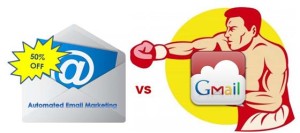
In case you missed it, Google recently revamped its inbox. This change impacts anyone who uses the popular Gmail web email service. The inbox redesign automatically sets up folders for users, who can then customize the folders further if they so desire. The default folders are divided into groups for primary emails, those from social media accounts and finally promotional emails.
As you can imagine, this redesign means that many users do not even check the promotional folder as they dismiss its contents as “junk” mail. This news is great for users who receive quite a few emails every day and need some help sorting through them. At the same time this news is devastating for marketers who have relied on email marketing campaigns.
Of course the change to Gmail’s inbox is so recent that nobody knows for sure how exactly it will impact email marketing. In fact, different studies of email response rates from marketers have indicated contradictory trends, both positive and negative. It will take more time and more thorough studies to pinpoint for sure what this change to Gmail really means. No matter what, businesses that rely on email marketing to any extent should stay aware of the situation as it rolls out in the coming months.
More bad news for marketers comes in the change to advertisements in the new inbox. Now advertisements are embedded at the top of the promotional emails folder in a way that makes them look like another email. This means email marketers will have to compete with ads as well as other marketing emails for customers’ attention.
One method for dealing with the situation that likely will not backfire is to ensure that your marketing emails are valuable to readers. This means your subject line of the email needs to have a compelling hook that is designed to appeal to your target demographic. Not only that, but your email needs to be read easily and be packed with valuable information. Fluff marketing emails will likely be discarded and forgotten, just as before, while emails from organizations that provide value will still be held onto, even if they sit in the promotional folder for a few days before they are read.
In these tough times it is important for businesses to remember to maintain or even improve their other marketing tools. These other tools actually become that much more valuable as email marketing becomes less effective. One area businesses should not neglect is making their website as good as possible, including ensuring it does not go through downtime or experience slow download speeds. Using SEO hosting service is an excellent way to avoid website problems.
Related reading: How to make your website load faster
Fortunately not all Internet users have Gmail inbox accounts. Still, a significant portion do, so the impact on email marketing will be felt by everyone. This change does not mean that you should stop sending marketing emails. Instead, it provides an excellent opportunity to reevaluate your email marketing strategy and hone it to make yourself more competitive in the marketplace.
How to link Facebook & Email Marketing for eCommerce promotion

How to combine Facebook Marketing & Email Marketing for eCommerce success
Linking Facebook Marketing and Email Marketing for eCommerce success: Many digital marketers make a cardinal mistake even today: they compartmentalize the different tools of online marketing. In a fluid world, especially in a dynamic domain like internet marketing, tools overlap and coalesce. Combining tools brings the best of two worlds together, giving your brand an unprecedented advantage. The flip side is that if you don’t know the tricks well, you may end up with the worst of both sides! In this post, I will share my thoughts about bringing together social media, represented by Facebook, and email marketing for ecommerce sites.
Joined at the Hip: Email Lists, Facebook Custom Audience & Facebook Lookalike Audience
It would be wrong to assume, for starters, that email marketing and Facebook are distinctly different. No, they are not! At least, not anymore. Facebook advertisement allows you to use email lists in custom audience. Even if you keep Facebook ads out of the picture, email lists can come in quite handy. Here’s how. Every ecommerce site collects emails from buyers and subscribers to promotional content. These email lists can be segregated according to heads that suit your purpose.
For example, if you sell shoes, segregate email lists according to the type of shoes picked up by these buyers. Knowing the buying patterns of customers give a clear indication of what they might be interested to buy in the near future. You will know about their preferences and with a bit of insight, grab data from Facebook. Combining email lists and buyer information with Facebook will give you a clear shot at targeted, specific social media marketing and promotion. Less of wastage, more of impact.
Coming back to Facebook ads, you are allowed to upload email lists. Facebook will offer you data by combining your uploaded email lists with similar buyer profiles. This will bring you in touching distance with a whole new circle of probable buyers. You can target them and create content aimed at these potential buyers. Your email list should exceed 100 and Facebook will generate a lookalike list. The larger your list is, the more data you can mine from Facebook because they will have a wider pool of data to glean from.
Launch both Flanks Together
You don’t have to fight for buyers with a single weapon at a time. You can do that simultaneously. That will give you a lethal age, more so when time is a major player in the arena. Look back at how you start your day daily after logging into your email. There are promotional emails sent out by brands. They talk about sales and additional discounts. You forget about it as soon as you check into Facebook.
What if there was the same kind of promotional content waiting for you on Facebook? On Twitter? Forgetting wouldn’t be that easy, would it? Most buyers are impulsive, especially during sale days. The hitch to getting to them is that you are not stressing on it enough or overdoing it. Three to five emails with the same content in a day is overkill. But offering the same content on emails and social media simultaneously drives home the point.
Identifying the Sale Buyers
Sale and extra discount days are norms of the marketing world today. You hear about Flash sales and limited period sales all the time online. There is a dedicated section of buyers who pick up products and services only during these sale phases. You can be quite sure that the next time you offer a sale, they will again be tempted to buy something! Identify them. When you offer a sale, during a product launch, for example, pick up email ids and list them under a head titled ‘Sale’.
The next time you offer a sale, make sure you create additional content for these subscribers on an email template. Follow this up with something similar on Facebook for these sale buyers in particular. The point will hit home and bring you dividends, I can personally vouch for that!
The Final Word
In the digital marketing world, opening up new flanks is the way forward. You shouldn’t restrict yourself to a particular avenue. Instead, use as many as you can to get to as many people as you can.





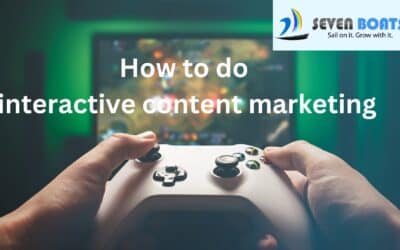
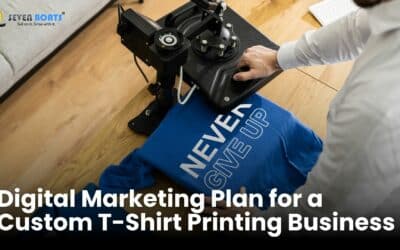
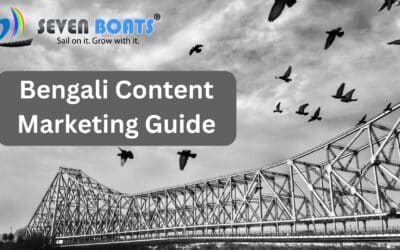
Thanks for the article. Step by step process to run a successful email marketing campaign given is very informative. The basics should always be clear for anyone wanting to work on email marketing and this is the article if anyone wants to go through the basics of email marketing campaign.
Thank you Savi for your positive feedback.
The information shared here is very thorough. The basic points described here will surely help any beginner to launch a successful email marketing campaign. Surely a great lesson for any beginner.
Thank you
Thanks for sharing the email marketing guide in a steady way. I found it very helpful and also its cleared my doubts. Specially the “Email Sending Timeline Infographics”. Could you please elaborate more on “Automated Drip feed / Triggered base email”
drip sequence or a drip email campaign or triggered email automation is an automated email marketing strategy designed to deliver several emails to a subscriber over a specific period. The emails are triggered by an event or action performed by the customer (such as first time subscription or clicking on download free ebook etc) and are set to go out at predetermined intervals.
For any given action, you can choose how many emails to send and the rate at which to send them (First email after sign up then after 7 days, then after 14 days, then after 30 days.. like this sequence ). These emails can be personalized with data like the contact’s name and specific references to the action they took.
Great post! Email marketing can be a powerful tool when done right. Your tips on running an effective email marketing campaign are spot on. I especially appreciate your emphasis on segmenting the audience, personalizing content, and optimizing for mobile devices. These strategies truly make a difference in engaging subscribers and driving conversions. Thank you for sharing these valuable insights!